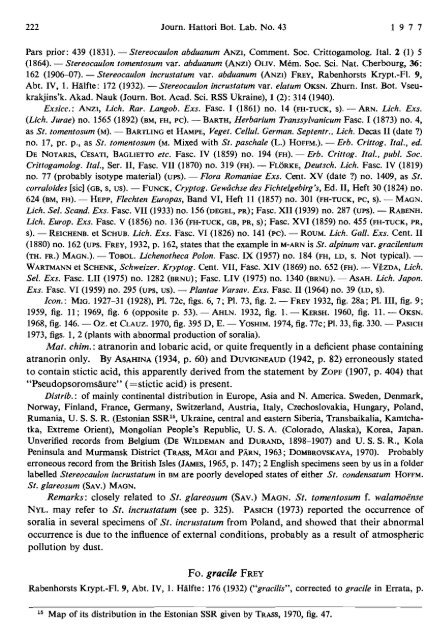A CONSPECTUS OF THE LICHEN GENUS STEREOCAULON ...
A CONSPECTUS OF THE LICHEN GENUS STEREOCAULON ...
A CONSPECTUS OF THE LICHEN GENUS STEREOCAULON ...
You also want an ePaper? Increase the reach of your titles
YUMPU automatically turns print PDFs into web optimized ePapers that Google loves.
222 Journ. Hattori Bot. Lab. No. 43 1977<br />
Pars prior: 439 (1831). -Stereocaulon abduanum ANZI, Comment. Soc. Crittogamolog. Ital. 2 (1) 5<br />
(1864). - Stereocaulon tomentosum var. abduanum (ANZI) OLIV. Mem. Soc. Sci. Nat. Cherbourg, 36:<br />
162 (1906-07). - Stereocaulon incrustatum var. abduanum (ANZI) FREY, Rabenhorsts Krypt.-F1. 9,<br />
Abt. IV, 1. Halfte: 172 (1932). - Stereocaulon incrustatum var. elatum OKSN. Zhurn. Inst. Bot. Vseukrakjins'k.<br />
Akad. Nauk (Journ. Bot. Acad. Sci. RSS Ukraine), 1 (2): 314 (1940).<br />
Exsicc.: ANZI, Lich. Rar. Langob. Exs. Fasc. I (1861) no. 14 (FH-TUCK, s). - ARN. Lich. EXS.<br />
(Lich. Jurae) no. 1565 (1892) (BM, FH, PC). - BARTH, Herbarium Transsylvanicum Fasc. I (1873) no. 4,<br />
as St. tomentosum (M). - BARTLING et HAMPE, Veget. Cellul. German. Septentr., Lich. Decas I1 (date ?)<br />
no. 17, pr. p., as St. tomentosum (M. Mixed with St. paschale (L.) H<strong>OF</strong>FM.). - Erb. Crittog. Ztal., ed.<br />
DE NOTARIS, CESATI, BAGLIETTO etc. Fasc. IV (1859) no. 194 (FH). - Erb. Crittog. Ztal., publ. Soc.<br />
Critlogamolog. Ztal., Ser. 11, Fasc. VII (1870) no. 319 (FH). - FLORKE, Deutsch. Lich. Fasc. IV (1819)<br />
no. 77 (probably isotype material) (UPS). -Flora Romaniae Exs. Cent. XV (date ?) no. 1409, as St.<br />
corraloides [sic] (GB, s, us). - FUNCK, Cryptog. Gewrichse des Fichtelgebirg's, Ed. 11, Heft 30 (1824) no.<br />
624 (BM, FH). - HEPP, Flechten Europas, Band VI, Heft 11 (1857) no. 301 (FH-TUCK, PC, s). - MAGN.<br />
Lich. Sel. Scand. Exs. Fasc. VII (1933) no. 156 (DEGEL, PR); Fasc. XI1 (1939) no. 287 (ups). - RABENH.<br />
Lich. Europ. Exs. Fasc. V (1856) no. 136 (FH-TUCK, GB, PR, s); Fasc. XVI (1859) no. 455 (FH-TUCK, PR,<br />
s). - REICHENB. et SCHUB. Lich. EXS. Fasc. VI (1826) no. 141 (PC). - ROUM. Lich. GUN. Exs. Cent. I1<br />
(1880) no. 162 (ups. FREY, 1932, p. 162, states that the example in M-ARN is St. alpinum var. gracilentum<br />
(TH. FR.) MAGN.). - TOBOL. Lichenotheca Polon. Fasc. IX (1957) no. 184 (FH, LD, S. Not typical). -<br />
WARTMANN et SCHENK, Schweizer. Kryptog. Cent. VII, Fasc. XIV (1869) no. 652 (FH). - VBZDA, Lich.<br />
Sel. Exs. Fasc. LII (1975) no. 1282 (BRNU); Fasc. LIV (1975) no. 1340 (BRNU). - ASAH. Lich. Japon.<br />
Exs. Fasc. VI (1959) no. 295 (ups, us). - Plantae Varsav. Exs. Fasc. I1 (1964) no. 39 (LD, s).<br />
Icon. : MIG. 1927-31 (1928), PI. 72c, figs. 6, 7; PI. 73, fig. 2. - FREY 1932, fig. 28a; PI. 111, fig. 9;<br />
1959, fig. 11; 1969, fig. 6 (opposite p. 53). - AHLN. 1932, fig. 1. - KERSH. 1960, fig. 11. -0~s~. 1968, fig. 146. - Oz. et CLAUZ. 1970, fig. 395 D, E. - YOSHIM. 1974, fig. 77c; PI. 33, fig. 330. - PASICH<br />
1973, figs. 1, 2 (plants with abnormal production of soralia).<br />
Mat. chim.: atranorin and lobaric acid, or quite frequently in a deficient phase containing<br />
atranorin only. By ASAHINA (1934, p. 60) and DWIGNEAUD (1942, p. 82) erroneously stated<br />
to contain stictic acid, this apparently derived from the statement by ZOPF (1907, p. 404) that<br />
"Pseudopsoromsaure" (=stictic acid) is present.<br />
Distrib.: of mainly continental distribution in Europe, Asia and N. America. Sweden, Denmark,<br />
Norway, Finland, France, Germany, Switzerland, Austria, Italy, Czechoslovakia, Hungary, Poland,<br />
Rumania, U. S. S. R. (Estonian SSR1q Ukraine, central and eastern Siberia, Transbaikalia, Kamtchatka,<br />
Extreme Orient), Mongolian People's Republic, U. S. A. (Colorado, Alaska), Korea, Japan.<br />
Unverified records from Belgium (DE WILDEMAN and DURAND, 1898-1907) and U. S. S. R., Kola<br />
Peninsula and Murmansk District (TRASS, MAGI and PARN, 1963; DOMBROVSKAYA, 1970). Probably<br />
erroneous record from the British Isles (JAMES, 1965, p. 147); 2 English specimens seen by us in a folder<br />
labelled Stereocaulon incrustatum in BM are poorly developed states of either St. condensatum H<strong>OF</strong>FM.<br />
St. glareosum (SAV.) MAGN.<br />
Remarks: closely related to St. glareosum (SAV.) MAGN. St. tomentosum f. walamoense<br />
NYL. may refer to St. incrustatum (see p. 325). PASICH (1973) reported the occurrence of<br />
soralia in several specimens of St. incrustatum from Poland, and showed that their abnormal<br />
occurrence is due to the influence of external conditions, probably as a result of atmospheric<br />
pollution by dust.<br />
Fo. gracile FREY<br />
Rabenhorsts Krypt.-F1. 9, Abt. IV, 1. Halfte: 176 (1932) ("'gracilis", corrected to gracile in Errata, p.<br />
'Wap of its distribution in the Estonian SSR given by TRASS, 1970, fig. 47.

















